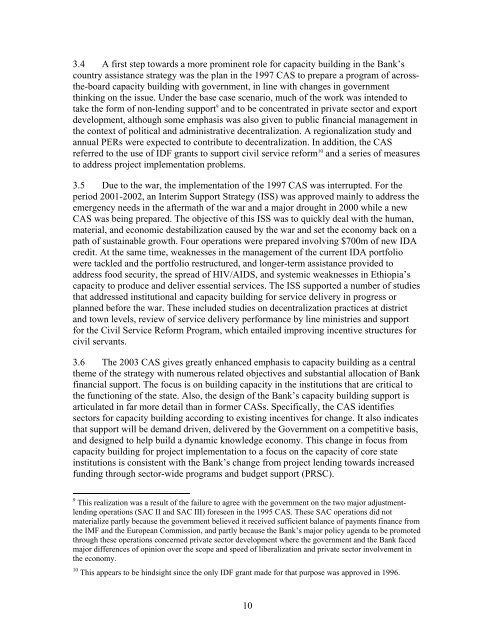An Independent Review of World Bank Support to ... - DAG Ethiopia
An Independent Review of World Bank Support to ... - DAG Ethiopia
An Independent Review of World Bank Support to ... - DAG Ethiopia
Create successful ePaper yourself
Turn your PDF publications into a flip-book with our unique Google optimized e-Paper software.
3.4 A first step <strong>to</strong>wards a more prominent role for capacity building in the <strong>Bank</strong>’scountry assistance strategy was the plan in the 1997 CAS <strong>to</strong> prepare a program <strong>of</strong> acrossthe-boardcapacity building with government, in line with changes in governmentthinking on the issue. Under the base case scenario, much <strong>of</strong> the work was intended <strong>to</strong>take the form <strong>of</strong> non-lending support 9 and <strong>to</strong> be concentrated in private sec<strong>to</strong>r and exportdevelopment, although some emphasis was also given <strong>to</strong> public financial management inthe context <strong>of</strong> political and administrative decentralization. A regionalization study andannual PERs were expected <strong>to</strong> contribute <strong>to</strong> decentralization. In addition, the CASreferred <strong>to</strong> the use <strong>of</strong> IDF grants <strong>to</strong> support civil service reform 10 and a series <strong>of</strong> measures<strong>to</strong> address project implementation problems.3.5 Due <strong>to</strong> the war, the implementation <strong>of</strong> the 1997 CAS was interrupted. For theperiod 2001-2002, an Interim <strong>Support</strong> Strategy (ISS) was approved mainly <strong>to</strong> address theemergency needs in the aftermath <strong>of</strong> the war and a major drought in 2000 while a newCAS was being prepared. The objective <strong>of</strong> this ISS was <strong>to</strong> quickly deal with the human,material, and economic destabilization caused by the war and set the economy back on apath <strong>of</strong> sustainable growth. Four operations were prepared involving $700m <strong>of</strong> new IDAcredit. At the same time, weaknesses in the management <strong>of</strong> the current IDA portfoliowere tackled and the portfolio restructured, and longer-term assistance provided <strong>to</strong>address food security, the spread <strong>of</strong> HIV/AIDS, and systemic weaknesses in <strong>Ethiopia</strong>’scapacity <strong>to</strong> produce and deliver essential services. The ISS supported a number <strong>of</strong> studiesthat addressed institutional and capacity building for service delivery in progress orplanned before the war. These included studies on decentralization practices at districtand <strong>to</strong>wn levels, review <strong>of</strong> service delivery performance by line ministries and supportfor the Civil Service Reform Program, which entailed improving incentive structures forcivil servants.3.6 The 2003 CAS gives greatly enhanced emphasis <strong>to</strong> capacity building as a centraltheme <strong>of</strong> the strategy with numerous related objectives and substantial allocation <strong>of</strong> <strong>Bank</strong>financial support. The focus is on building capacity in the institutions that are critical <strong>to</strong>the functioning <strong>of</strong> the state. Also, the design <strong>of</strong> the <strong>Bank</strong>’s capacity building support isarticulated in far more detail than in former CASs. Specifically, the CAS identifiessec<strong>to</strong>rs for capacity building according <strong>to</strong> existing incentives for change. It also indicatesthat support will be demand driven, delivered by the Government on a competitive basis,and designed <strong>to</strong> help build a dynamic knowledge economy. This change in focus fromcapacity building for project implementation <strong>to</strong> a focus on the capacity <strong>of</strong> core stateinstitutions is consistent with the <strong>Bank</strong>’s change from project lending <strong>to</strong>wards increasedfunding through sec<strong>to</strong>r-wide programs and budget support (PRSC).9 This realization was a result <strong>of</strong> the failure <strong>to</strong> agree with the government on the two major adjustmentlendingoperations (SAC II and SAC III) foreseen in the 1995 CAS. These SAC operations did notmaterialize partly because the government believed it received sufficient balance <strong>of</strong> payments finance fromthe IMF and the European Commission, and partly because the <strong>Bank</strong>’s major policy agenda <strong>to</strong> be promotedthrough these operations concerned private sec<strong>to</strong>r development where the government and the <strong>Bank</strong> facedmajor differences <strong>of</strong> opinion over the scope and speed <strong>of</strong> liberalization and private sec<strong>to</strong>r involvement inthe economy.10 This appears <strong>to</strong> be hindsight since the only IDF grant made for that purpose was approved in 1996.10
















